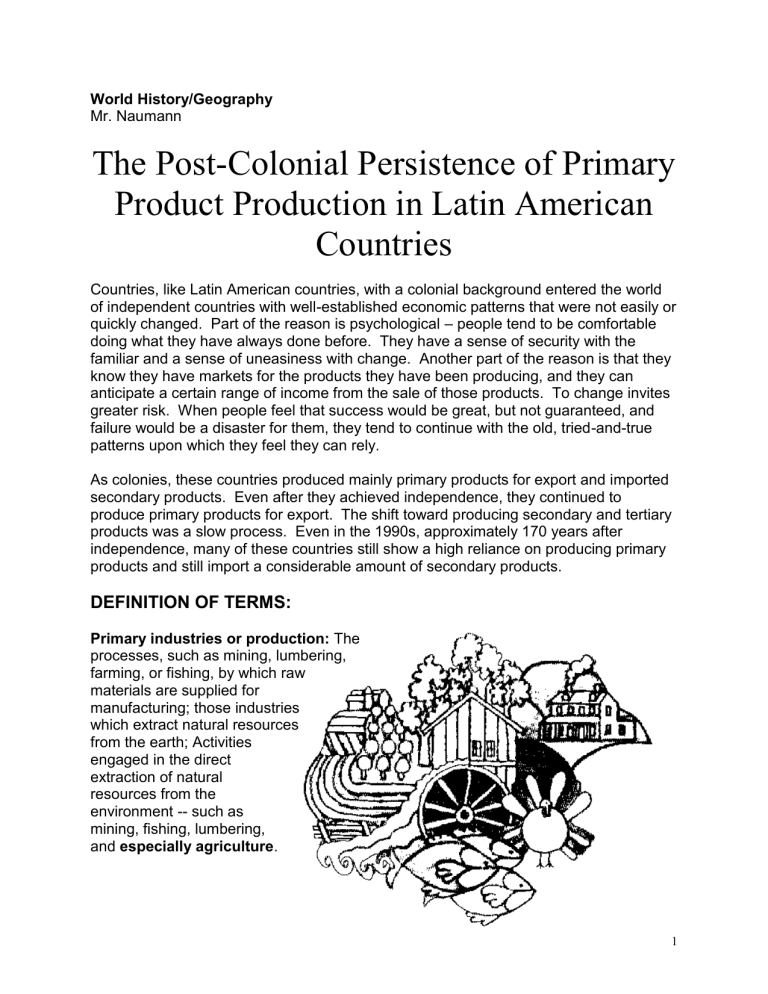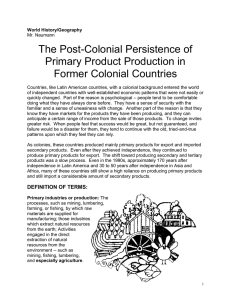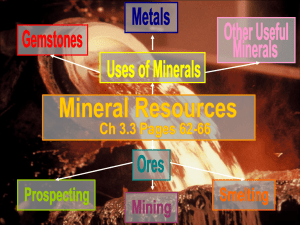Post Colonial Economic Patterns

World History/Geography
Mr. Naumann
The Post-Colonial Persistence of Primary
Product Production in Latin American
Countries
Countries, like Latin American countries, with a colonial background entered the world of independent countries with well-established economic patterns that were not easily or quickly changed. Part of the reason is psychological
– people tend to be comfortable doing what they have always done before. They have a sense of security with the familiar and a sense of uneasiness with change. Another part of the reason is that they know they have markets for the products they have been producing, and they can anticipate a certain range of income from the sale of those products. To change invites greater risk. When people feel that success would be great, but not guaranteed, and failure would be a disaster for them, they tend to continue with the old, tried-and-true patterns upon which they feel they can rely.
As colonies, these countries produced mainly primary products for export and imported secondary products. Even after they achieved independence, they continued to produce primary products for export. The shift toward producing secondary and tertiary products was a slow process. Even in the 1990s, approximately 170 years after independence, many of these countries still show a high reliance on producing primary products and still import a considerable amount of secondary products.
DEFINITION OF TERMS:
Primary industries or production: The processes, such as mining, lumbering, farming, or fishing, by which raw materials are supplied for manufacturing; those industries which extract natural resources from the earth; Activities engaged in the direct extraction of natural resources from the environment -- such as mining, fishing, lumbering, and especially agriculture .
1
Secondary industries or production:
Secondary industries process the products of primary industries (raw materials) and turn them into finished industrial products. This is the manufacturing sector of an economy.
Tertiary industries or production:
Tertiary industries assist primary and secondary industries to function efficiently by providing services -- education, information, management, banking, and distribution of their products.
Special Note: One might consider adding a category between primary and secondary products – intermediate production . Iron ore is clearly a primary product, a raw material. When iron ore is processed and becomes ingots of iron, sheets of iron, rods of iron, tubes of iron, or bars of iron, these are not finished products that consumers rush out to buy. These processed products are purchased by other industries and turned into finished products. The true secondary products is the automobile with a large amount of steel in it or the kitchen appliance with parts and an exterior housing made of steel.
Primary Product
Animal hides
Iron ore
Coffee beans
Tropical hardwood logs or rough-cut lumber
Wool
Wheat
Intermediate Product Secondary Product
Leather Leather products – shoes, brief cases, luggage, belts, clothing, etc.
Steel (sheet, bar, tube, etc.) Automobile, appliances, industrial machinery
Roasted beans or packaged ground coffee or
Finished tropical hardwood lumber
Wool cloth ??? instant coffee
Furniture or wall paneling of tropical hardwood
Wool cloth (for those who
Flour make their own clothing) or wool clothing
Pasta, bread, and other food products made from wheat flour
2
What’s the Problem With Primary Products?
Primary products usually have much lower value (sale price) than the finished products made from the processed primary products. Countries that export primary products usually have much competition from other countries and have little control over the price they receive for their products. The profits made from primary production are smaller than those made by intermediate and secondary producers, and the foreign exchange currency a country earns is less from exporting primary products than it is from exporting intermediate and secondary products.
Countries that import primary products and export secondary products usually have more influence on the prices they pay for primary products and the prices they receive for their secondary products. The firms usually earn higher profits, and the countries usually earn more foreign exchange dollars.
A country moving from mainly primary production to increased intermediate and secondary production benefits because it can import less of the easier-to-produce secondary products and use its valuable foreign exchange currency to purchase capital goods needed for further industrial expansion and development. By exporting some secondary products and intermediate products and fewer primary products, it can earn more foreign exchange currency and be in a better position to purchase high-tech, expensive secondary capital goods.
LATIN AMERICAN
IMPORTS: food stuffs, machinery, transportation equipment, iron and steel, semimanufactures, chemicals, fuels and lubricants, clothing, electrical equipment, agricultural machinery, basic manufactures, wheat, fertilizer, motor vehicles, capital goods, consumer durables, spare parts, coal, consumer goods
LATIN AMERICAN
EXPORTS: Meat, wheat, corn, oilseeds, hides, sugar, garments, seafood, citrus, metals, natural gas, coffee, soybeans, coffee, foodstuffs, iron ore, coal, petroleum, bananas, cotton, cocoa beans, nutmeg, bauxite, rice, lumber, shrimp, light manufactures, alumina, engines, copper, fishmeal, wood pulp, molybdenum,
Industrial products
3




